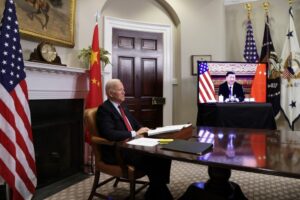The White House’s new Indo-Pacific Strategy cites allies and partners in the region as the U.S.’ “single greatest asymmetric strength” to counter China, and calls for bolstering collaboration on emerging technologies and development of advanced capabilities.
“We will foster security ties between our allies and partners in the Indo-Pacific region and beyond, including by finding new opportunities to link our defense industrial bases, integrating our defense supply chains, and co-producing key technologies that will shore up our collective military advantages,” the White House writes in the document. “We will foster security ties between our allies and partners in the Indo-Pacific region and beyond, including by finding new opportunities to link our defense industrial bases, integrating our defense supply chains, and co-producing key technologies that will shore up our collective military advantages.”

The new strategy, which follows the Trump administration’s own version in 2019, includes goals to modernize our long-standing alliances, strengthen emerging partnerships, and invest in regional organizations, emphasizing several times how partnerships can be leveraged to advance operational concepts and technology innovation.
“We will renew our focus on innovation to ensure the U.S. military can operate in rapidly evolving threat environments, including space, cyberspace, and critical- and emerging-technology areas. We are developing new concepts of operations, building more resilient command and control, increasing the scope and complexity of our joint exercises and operations, and pursuing diverse force-posture opportunities that will strengthen our ability to operate forward and more flexibly with allies and partners,” the White House writes.
More specifically, the Biden administration says it will focus on “open access to scientific data for cutting-edge collaboration” and “work to implement the framework of responsible behavior in cyber space and its associated norms.”
The White House’s new strategy follows the Pentagon’s recent Global Posture Review, which also emphasized additional cooperation with allies and partners in the Indo-Pacific “to advance initiatives that contribute to regional stability and deter potential military aggression from China” (Defense Daily, Nov. 29 2021).
“[China] is combining its economic, diplomatic, military, and technological might as it pursues a sphere of influence in the Indo-Pacific and seeks to become the world’s most influential power,” the White House writes in its strategy. “Our collective efforts over the next decade will determine whether [China] succeeds in transforming the rules and norms that have benefitted the Indo-Pacific and the world.”
The Biden administration said its strategy includes “deepening” regional treaty alliances with Australia, Japan, South Korea, the Philippines, and Thailand and strengthening relationships with regional partners such as India, Indonesia, Malaysia, Mongolia, New Zealand, Singapore, Taiwan, Vietnam, and the Pacific Islands.
The State Department on Thursday approved a potential sale worth up to $13.9 billion for 36 Boeing [BA] F-15ID fighters to Indonesia, in the event that Jakarta plans to pursue the aircraft as part of its ongoing military modernization initiative (Defense Daily, Feb. 10).
Officials cite the Quad strategic security dialogue with India, Japan and Australia and the new AUKUS trilateral security partnership the U.K. and Australia as opportunities to bring in partners to work on critical and emerging technologies.
Last week, the White House released an updated list of 19 key technology areas relevant to national security, to include advanced computing, artificial intelligence, autonomous systems and robotics, biotechnologies, communication and networking technologies, directed energy, quantum information technologies, semiconductors and microelectronics, and space technologies and systems (Defense Daily, Feb. 8).